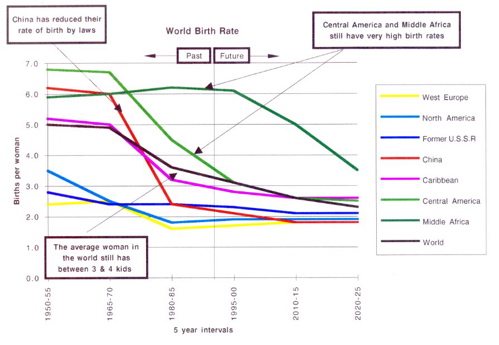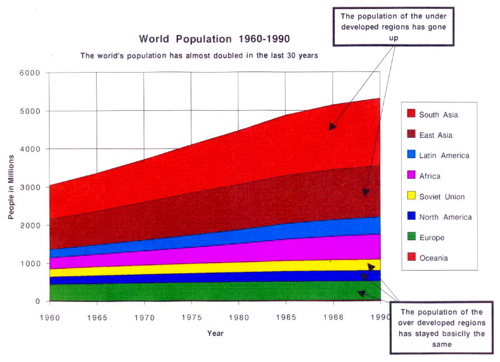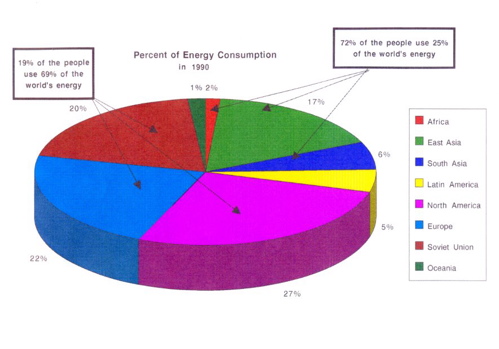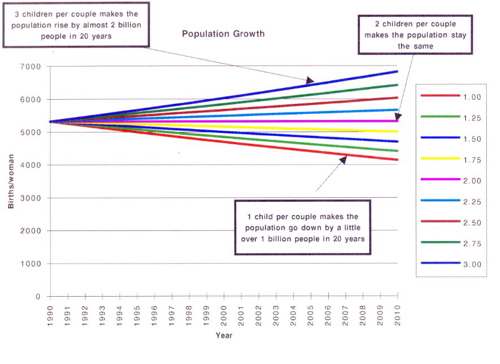Overpopulation:
How Bad Is It?
By Serena Lehman (1994)
Extended by Don Lehman Jr. (2014)
- Overpopulation, a root cause of many global problems
- Mass Starvation forces China to reign in Population Growth.
- Why such a Big Concern?
- Over Consumption by Too Many People: the Real Problem
- Most of the Population Growth Occurs in Under-developed Countries
- Population Pressures from Excessive Consumption in Over-developed Countries
- How to stop the population growth
- Bibliography
Overpopulation, a root cause of many global problems
Overpopulation is the root cause of many of the world’s environmental problems. Dirty water, the energy crisis, poverty, and hunger – these are just some of the problems associated with meeting the needs of Earth's 5.5 billion people. The Earth is a phenomenal supplier of natural resources, such as food, water, energy, and building materials. But how long can she keep supplying these things to all her creatures?
“With the world’s population expected to double in the next 30 years, overpopulation is by far the greatest threat facing humanity,” according to Drs. Laurie Vitt and Janalee Caldwell, professors of zoology who have been doing research in the Amazon basin of South America.
Between 1980-1985, 128 million people were born in the world. This will rise to about 150 million births in the 5 year interval before the year two thousand.
“The current population of 5.5 billion, growing at an annual rate of 1.7%, will add approximately 93 million people this year, equivalent to more than the population of Mexico,” says Dr. Paul Ehrlich, author of The Population Bomb, and Dr. Gretchen Dailey in a 1992 article.
This is way too many. With that many people in the world, the resources will be used up much more quickly. In 1986 humans consumed 40% of the annual resources available to sustain life.
“Projected increases in population alone could double this level of exploitation, causing the demise of many ecosystems on whose services human beings depend,” say Ehrlich & Dailey.
Each person represents many Generations to come
Oceania has only 0.5% 0f the world’s population, while Asia contains 59.1% of the world’s population. But we’re all in this together. Every person counts. One person represents many generations to come. Human beings must do something smart and now.
Mass Starvation forces China to reign in Population Growth
In the past, people attempted to replenish and even increase the population of the world. War, famine, plague, disease and pestilence regularly reduced the size of the community. Further, infant mortality was high; life spans were shorter; and natural resources seemed to be plentiful. The world’s population was growing very fast, but it seemed that there was plenty to go around.
As such, couples did not worry about having too many children. As recently as 1970, the number of offspring in an average family on our fair planet was 5. This large family size combined with better medical care led to an enormous growth in population. This had fatal consequences for at least one country.
Between 1950-55, 25 million people were born in China. This had grown to 29 million between 1965-70. Because of mass starvation, millions of Chinese died in the late 1970s. Because of this tragedy, strict laws were passed limiting family size. In 1950 China had the highest birth rate in the world. Each Chinese woman had an average of 6 children. Because of the laws the birth rate in China has dropped to 2.4 children per Chinese woman in the 1980s.

The graph shows how effective the laws were. But the laws followed great famine and starvation. We don’t want that to happen to us. It would be a better to limit population growth before the problems from too many people gets out of hand.
California’s population has risen a lot in the last 50 years. In 1940 there was 10 million people in California but it is now 30 million. It climbs about 5 million each 5 years. Much of this increase is due to immigration. This shows how population control is everyone’s problem because the people from countries with higher birth rates are immigrating to countries with lower birth rates.
Why such a Big Concern?
With the world’s population growing so fast, the environment is being destroyed. Increasing numbers of people have an increasing number of needs, such as the basics – food, clothing and housing. This means that the water, food, building materials and energy will be used up more rapidly. Therefore, the resources will have to be replenished a lot quicker. Some of the renewable resources are trees, freshwater and pollinators. However, people are using them so fast they can not renew themselves.
Water
Water is all over the world so we don’t think about it as a big concern, but it is a very big concern. Salt water is not the concern; it is fresh water. Freshwater comes from lakes, rain, streams and aquifers. The earth naturally purifies water, but not as quickly as our population uses it. Also people are dirtying up the water and polluting the air so that our fresh water from the sky turns into acid rain. Human systems can purify water, but it takes a lot of energy. If people don’t start conserving soon, there will be not enough freshwater to drink. As a result, humans will begin dying from drinking polluted water. Emergency measures, like the ones China used, will be called for.
Trees
Trees are important to our ecosystem. They supply us with oxygen. Also the big trees hold soil and mountainsides together. The more big trees cut down, the more erosion. That will destroy our mountains, valleys, and rivers. It takes much less time to cut down a tree, than it does to grow one. It is good that people are planting trees to replace the ones we cut down. But we need to reduce demand on trees by reducing population size. People need trees to stay alive.
Non-renewable Resources
Nonrenewable resources, the ozone, tropical forests, and fossil fuels are a greater worry. With the population growing so fast, they will run out before we know it. They are being taken for granted.
Ozone
The ozone right now has two holes, one over Australia and one starting over the North Pole. They are mostly created by chloroflourocarbons (CFC’s). They destroy ozone which protects people from ultra violet rays. With not as much protection, skin cancer in more easily developed. The holes are getting bigger and we can not fix them. But people can keep the holes in the ozone the same size by reducing the amount of CFC’s we use everyday.
Fossil Fuels
Fossil fuels are used by cars, plastics, heating, plus many others. Unlike trees, fossil fuels are not a renewable resource. When they run out, they are gone for good. The more people there are, the faster the fossil fuels are used. Humans must both check population growth and find other ways of doing things; else the fossil fuels will run out and there won’t be any left for future generations.
Tropical Rainforests
The tropical forests won’t be here forever, as people may think. Acres of rain forests are being cut down every day for paper, agriculture, homes, etc. The tropical forests supply the earth with most of it’s clean air. It also is home for many animals. Many species are becoming extinct or threatened by extinction because we are destroying their habitats by deforestation. Many animals that we do not even know about are now extinct. People burn down rainforests so they can have farming. The farming that is placed there frequently does not work because the soil is not meant for farming or anything else except for growing tropical growth.
Human beings can not live with out any of those things. Yet we are ruining them or using them up. People can’t just leave the earth and live on Mars. Humans could not survive on Mars very long because it does not accommodate the things people need. Water and oxygen are two of the more important things the make it possible to live, but Mars does not have either of them. How would we survive? Human beings belong on Earth, it is their natural habitat. If we use up all our resources, our standard of living will be degraded or perhaps human beings might become extinct.
Over Consumption by Too Many People: the Real Problem
A common brain condition makes people do some really stupid things. One of the really stupid things is denying the real problem and making it something else. Another stupidity is that people say they will do something, but they never do. This disastrous combination makes it difficult to deal with the problems of overpopulation.
Most ignore the consequences of overpopulation, instead focusing their energies upon other social issues. Many people say, rightfully so, that waste is a big problem. Gratefully, many governments are passing legislation to regulate waste by instituting recycling programs. Conserving resources is obviously part of the solution. While conservation is certainly a step in the right direction, the hidden cancer is consumption.
Every human must consume natural resources to survive. Each individual requires food, clothing, and shelter. Further, the couple needs some kind of income, most frequently associated with a job, to provide these essential items. In other words, every new born child, whether rich or poor, will be a resource consumer. Despite the best conservation measures, an accelerating number of people consume an accelerating amount of resources. Conservation is secondary to the number of people requiring food, clothing, housing and jobs. Again it is obvious that overpopulation is the root problem.
Why is their resistance to tackling the population problem?
Some are in a state of denial, while others are afraid to challenge traditional belief systems. Certain religions encourage large families to increase their congregation – teaching that God will provide. Others feel that couples should be able to have as many children as they want, just as humans have always done. Unfortunately, circumstances have changed. The global population has nearly doubled in the last 30 years. Supporting this huge increase in the number of people has put a huge strain on our natural resources. Consumption grows more quickly than our efforts at conservation. Population control is the essence of the solution to over-consumption.
Most of the Population Growth Occurs in Under-developed Countries
It is evident that consumption is the devastating side effect of population. This has some interesting ramifications.
Many citizens in the over-developed countries agree that overpopulation is a problem. However, they project the problem onto the under-developed countries. They rationalize this attitude by citing statistics showing that population is even falling in some of the over-developed countries, notably Japan. This perspective certainly has some validity.
The population of the Earth's over-developed regions, i.e. North America, Europe and Russia, has only grown slightly in 30 years. In contrast, the rest of the world has contributed 2 billion new mouths to feed, accompanied by bodies that require clothing, shelter and jobs.

In fact, most of the world's population in the world lives in the under-developed countries. Note that Asia and Africa contain 72% of the people on the planet.

These overwhelming figures illustrate that population growth is not a big problem in over-developed countries, such as the United States, Russia or Europe. Africa, India, and China have provided most of the additional people on the planet. China was the first to feel the devastating effects of too many people and not enough resources. We laud them for passing legislation to at least contain the problem. India and Africa continue to reel from the consequences of unrestrained breeding – wide spread poverty combined with regular famines.
While devastating to the country in question, the resource depletion in under developed countries is primarily a local problem with limited effect upon the rest of the planet. Each of the countries has a limited amount of resources that are depleted to feed their local population. Certainly international aid is channeled to the countries in question. This outside assistance, of course, drains global resources.
Population Pressures from Excessive Consumption in Over-developed Countries
From this perspective, it seems that population is not a local issue. It is easy to think that population is a global problem to be dealt with by international politicians. We rationalize that we have so much that we are able to help others. However, as mentioned, the main problem with overpopulation is overconsumption. Russia, North America, and Europe, while having small population growth, are the biggest energy consumers. Although they only contain 20% of the population, they consume 70% of the energy. Most of this energy comes from non-renewable oil.

Let's look at energy consumption on an individual level. First, let's look at the over-developed territories. On the average, each American consumes 273 energy units per year – Russians 191 – and Europeans 150. Now the underdeveloped territories: the citizens of East Africa consume 1 energy unit per year, India 4, Indonesia 8 and China 26. What a huge contrast.
| circa 1990 | Energy use per Person |
Population in Millions) |
|---|---|---|
United States |
273 |
248 |
| Russia | 191 |
291 |
| Europe | 150 |
470 |
| Japan | 111 |
123 |
China |
26 |
1120 |
| Indonesia | 8 |
180 |
| India | 4 |
842 |
| East Africa | 1 |
182 |
| Middle Africa | 2 |
58 |
Roughly speaking the people in over-developed countries consume 100 times more energy than those in under-developed countries. In terms of energy usage, each American is worth 273 Central Africans. No matter how much we conserve, we Americans consumes an enormous amount of energy in contrast with an India, African, or Chinese. We can't avoid using electricity, natural gas and gasoline that is a standard part of our cultural environment. We will, of course, continue to have children. However, when considering a 3rd or even a 4th child, remember that 4 American children consume as much energy as 1100 Africans.
Many people understand the problems of overpopulation. However, many Americans continue to have big families. Some couples feel that having a large family won't be a problem if they can afford it. They don't seem to realize that each child represents a new generation of people using up our precious resources, needing housing and employment. American President, Bill Clinton claims that he wants to bring “population to the forefront of America’s international priorities.” But we need to make it a domestic priority also.
How to Stop the Population Growth
Humans are their own worst enemy. There is not much hope for the human species if we don’t reduce population growth and conserve natural resources. There is much people can do.
• 1) Couples should limit family size. That would make the population decrease rapidly. Notice the following graph. At 3 children per couple, the global population rises by almost 2 billion in 20 years. If each couple has only one child, the number of people on the Earth would fall by a little over a billion. (As usual, it is easier to put on life, than it is to take it off.)

• 2) Besides reducing family size, couples should wait until the age of 30 for their first child. The population benefits are straightforward. If women have their first child as a teenager at the age of 16, 6 generations of consumers are born in a century. Conversely, if women wait until their 30s to have their first child, there are only 3 generations born in 100 years. In other words, teenage mothers create the possibility of twice as many children as when a couple waits until their 30s to have offspring. Delaying pregnancy is an easy solution to population pressure.
• 3) Schools should teach children about the overpopulation problem and dwindling resources. Educators should also instruct about the solutions: contraception to reduce family size and delaying pregnancy.
• 4) Abortions should be allowed. Because of the problems of overpopulation, we certainly don’t need any unwanted births.
All these things would decrease population. In response, energy and resource consumption would also drop. Simultaneously housing and jobs would become more available.
It might seem that having less children is all that we can do on an individual level. Yet there is a lot we can do. The next generation has already been born. We must educate them and others about the problems of overpopulation. We must inform our friends and tell them to tell their friends. Educating people about the problems of overpopulation is one of the best things that we can do to lower the population. Hopefully humans will be saved.
Bibliography
“Are Human Beings Endangered Species.” Editorial. USA Today August 1992: 1-2.
Daily, Gretchen and Erlich, Paul. “Population Sustainability, and Earth’s Carrying Capacity.” Bioscience November 1992: 761-770.
Almanac. Environmental Almanac, New York: Houghton Mifflin Company, 1993.